List of kebabs facts for kids
Kebabs are super popular dishes made from cooked meat, often found in Middle Eastern cuisine and many Muslim countries. While you might think of kebabs as meat on a skewer, many types don't use skewers at all! They can be grilled, roasted, or even fried. This article will take you on a tasty tour of different kebabs from around the world.
Contents
Azerbaijan
Azerbaijan has its own special kebab traditions. Here are a few:
| Name | Image | Description |
|---|---|---|
| Lülə kabab |  |
This kebab is often served on a skewer or wrapped in thin lavash bread. |
| Tikə kabab | This is a type of shashlik, which means skewered meat. | |
| Sham kebab | A unique kebab from Azerbaijan. | |
| Tava kebab | This kebab is cooked in a pan (tava means pan). |
India
India is famous for its rich and spicy food, and kebabs are a big part of that!
| Name | Image | Description |
|---|---|---|
| Bihari kabab |  |
Pieces of beef are marinated in spices, yogurt, and chilies. They are then grilled slowly over charcoal until perfectly tender. This dish came from Bihar, India. |
| Boti kebab |  |
This is a delicious mutton (lamb or goat meat) kebab. You can see it at the bottom of the picture. |
| Naga doner kebab | A very spicy kebab from British Bangladeshi communities in East London, England. Meat is cooked on a tall spinning grill and topped with super hot Naga morich chili. | |
| Jali kebab | A soft, net-like kebab that might have come from Old Dhaka. Jali means net, which describes its look. | |
| Kathi kebab |  |
Beef, chicken, or mutton kebab wrapped in a layered porota (a type of flatbread). The meat is mixed with onions, chilies, and sauces. |
| Reshmi kebab | Made from minced chicken, seasoned well, and then grilled on a charcoal barbecue. | |
| Seekh kebab |  |
Prepared with minced meat and spices, then grilled on skewers. It's often served with a cooling sauce like Raita or mint sauce. |
| Shami kebab |  |
Usually made from minced meat mixed with lentils, onion, coriander, and green chilies. It's shaped into a disc and fried, often in ghee (clarified butter). |
| Shatkora doner kebab | Another popular British Bangladeshi kebab from East London. Meat is cooked on a spinning grill and flavored with the Shatkora fruit. | |
| Shutli kebab |  |
This kebab is made by wrapping spiced meat paste around a metal skewer and tying it with a cotton thread (shuta in Bengali). After cooking, the thread is removed. |
| Tikka kebab |  |
Chunks of chicken are marinated in yogurt, sauces, and spices, then grilled. |
China
In China, especially in the Xinjiang region, kebabs are a popular street food.
| Name | Image | Description |
|---|---|---|
| Chuanr |  |
This is the most popular kebab in Xinjiang. It's made of chunks of mutton (lamb) or mutton fat on skewers, grilled over coals. It's seasoned with cumin and chili paste. You can find Chuanr made with chicken, pork, beef, and seafood too. |
Cyprus
Cyprus offers its own delicious grilled meat dishes.
| Name | Image | Description |
|---|---|---|
| Sheftalia |  |
A traditional Cypriot sausage made from ground pork or lamb. It's wrapped in a special fat and can be served alone or in a pita bread with tomato, cucumber, parsley, and lemon. |
| Souvlaki |  |
Skewers of pork, chicken, or lamb that are barbecued. The picture shows a souvlaki platter. |
Greece
Greece has some famous kebab-like dishes, often served in pita bread.
| Name | Image | Description |
|---|---|---|
| Gyros | 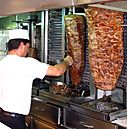 |
Introduced in the 1950s, gyros is made from pork or chicken meat. It's formed into a large loaf and slow-roasted on a vertical spinning grill. Thin slices are shaved off and served in pita bread with onion, tomato, fried potatoes, and Greek tzatziki sauce. |
| Souvlaki | Skewered pieces of pork meat, similar to those found in Cyprus. | |
| Kleftiko | This is lamb slow-baked on the bone, first marinated in garlic and lemon juice. It was traditionally cooked in a pit oven. | |
| Kontosouvli | Large pieces of pork meat are spun on a skewer until cooked. It's served chopped on a wooden plate or paper. |
Iran
Iranian cuisine features many types of kebabs, often served with rice.
| Name | Image | Description |
|---|---|---|
| Joujeh kabab |  |
Grilled chicken on skewers. Joujeh means roasted chicken. |
| Kabab bakhtiari | A mix of jujeh kabab (chicken) and kabab barg (sirloin). | |
| Kabab barg |  |
Grilled marinated sirloin (a type of beef). |
| Kabab barreh | Grilled lamb, often marinated in yogurt with parsley. | |
| Kabab chenjeh | Grilled lamb prepared like shish kebab, but without vegetables. | |
| Kabab koobideh |  |
Made from ground beef or lamb, mixed with parsley and chopped onions. It's shaped into a flat strip and grilled on wide skewers. |
| Kabab torsh |  |
Grilled beef marinated in a mix of pomegranate juice, walnuts, parsley, garlic, and olive oil. Torsh means sour. |
Levant
The Levant region (including Syria, Lebanon, and parts of Israel) has many unique kebab dishes.
| Name | Image | Description |
|---|---|---|
| Kebab halabi | A kebab served with a spicy tomato sauce and Aleppo pepper. It's very common in Syria, Lebanon, and the Galilee region. It's named after the city of Aleppo, which is famous for its many kebab recipes. | |
| Kebab khashkhash |  |
Rolled lamb or beef mixed with chili pepper paste, parsley, garlic, and pine nuts. The picture shows Kebab khashkhash from Aleppo. |
| Shawarma | 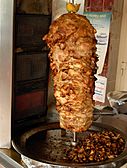 |
Similar to a doner kebab, this dish is traditionally made with chunks of lamb, but also chicken, turkey, beef, or veal. The meat is cooked on a vertical rotisserie. |
Nigeria
Nigeria, especially in the north, has a popular spicy meat kebab.
| Name | Image | Description |
|---|---|---|
| Suya |  |
A popular spicy meat kebab enjoyed across West Africa. It's a recipe from the Muslim Hausa people in northern Nigeria. This kebab tastes of peanuts and spicy pepper. It's often sold by street vendors and served with onion and bell pepper pieces. |
Pakistan
Pakistan has a rich variety of kebabs, often grilled or fried.
| Name | Image | Description |
|---|---|---|
| Chapli kebab |  |
A special dish from the Khyber Pakhtunkhwa province of Pakistan. It's made from marinated beef, shaped flat, and deep-fried. |
| Lola kabab/Gola kabab | These are rolled meatballs, originally from Peshawar in Pakistan and Kandahar in Afghanistan. | |
| Seekh kebab |  |
Prepared with minced meat and spices, then grilled on skewers. It's cooked in a Tandoor (a clay oven) and often served with chutneys or mint sauce. |
| Shami kebab |  |
Made from minced meat, mixed with lentils, onion, coriander, and green chilies. It's shaped into a disc and fried, often in ghee. |
| Reshmi kebab | 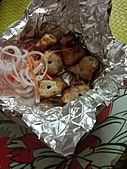 |
Minced chicken, seasoned well, and then barbecued on a charcoal grill. |
Portugal
Portugal offers its own take on skewered meat.
| Name | Image | Description |
|---|---|---|
| Espetadas |  |
Meat skewers, usually made with beef. |
Romania
Romania has a popular grilled meat skewer dish.
| Name | Image | Description |
|---|---|---|
| Frigărui |  |
Small pieces of meat (like pork, beef, lamb, or chicken) grilled on a skewer. It's very similar to shashlik or shish kebab. Sometimes, meat pieces are alternated with bacon, sausages, or vegetables like onions and tomatoes. |
South Africa
South Africa has a unique kebab-like dish from its Cape Malay community.
| Name | Image | Description |
|---|---|---|
| Sosatie | 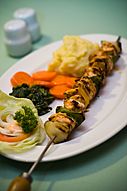 |
A dish from the Cape Malay people of South Africa. It's a type of kebab related to satay, which came to Indonesia from Muslim traders and then to South Africa. |
Spain
Spain has its own version of a meat skewer.
| Name | Image | Description |
|---|---|---|
| Pincho moruno |  |
Meat skewers, usually made of chicken or pork cut into cubes. The meat is marinated in paprika and other spices. |
Turkey
Turkey is often considered the home of many kebab types, with a huge variety of delicious dishes.
| Name | Image | Description |
|---|---|---|
| Adana kebabı |  |
Also known as kıyma kebabı. It's made with hand-minced meat mixed with chili on a flat, wide metal skewer. It's popular all over Turkey, but especially in the Adana region. |
| Alinazik kebab |  |
Ground meat kebab cooked in a pan, then mixed with garlic, yogurt, and eggplants. |
| Beyti kebab |  |
Ground lamb or beef, seasoned and grilled on a skewer. It's often served wrapped in lavash bread and topped with tomato sauce and yogurt. |
| Cağ kebabı |  |
Cubes of lamb are roasted first on a horizontal spinning spit (a cağ), then on a skewer. It's a specialty from the Erzurum region. |
| Ciğer kebabı |  |
Lamb liver kebab on a skewer. Ciğer means liver. |
| Çökertme kebabı |  |
Sirloin veal kebab served with yogurt and potatoes. |
| Çöp şiş |  |
A specialty from Selçuk and Germencik. It's made with pounded boneless meat, tomatoes, and garlic, marinated with black pepper, thyme, and oil on wooden skewers. |
| Doner kebab |  |
Meat cooked on a vertical rotisserie, then thinly sliced. It's one of the most famous kebabs worldwide. |
| İskender kebap |  |
Doner kebap served with yogurt, tomato sauce, and butter. It was created by İskender Efendi in Bursa in 1867. |
| İslim kebabı |  |
A version of the aubergine (eggplant) kebab without its skin, marinated in sunflower oil. |
| Kağıt kebabı |  |
Lamb (or veal) cooked inside a paper wrapping. Kağıt means paper. |
| Şiş köfte |  |
Minced lamb meatballs mixed with herbs like parsley and mint, placed on a stick and grilled. |
| Kuzu şiş |  |
Shish kebap made with marinated milk-fed lamb meat. Kuzu means lamb. |
| Patlıcan kebabı |  |
A unique kebab where meat is marinated in spices and served with aubergines (eggplants), hot pide bread, and a yogurt sauce. |
| Şiş kebabı |  |
Prepared with fish, lamb, or chicken meat on thin metal or reed rods, then grilled. This is the classic "meat on a stick" kebab. |
| Şiş tavuk | 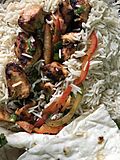 |
Yogurt-marinated chicken grilled on a stick. Tavuk means chicken. |
| Lamb tandoori | 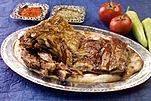 |
Lamb pieces (sometimes a whole lamb) baked in a special oven called a tandır for many hours. It's served with bread and raw onions. |
| Tantuni | 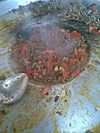 |
A spicy wrap (dürüm) with julienne cut beef or lamb. The meat is stir-fried on a sac (a type of pan) with a hint of cotton oil. It's a specialty of Mersin, Turkey. |
| Tas kebap |  |
A stewed meat dish cooked in a bowl. The vegetables are cooked in butter first, then the meat is cooked in the same flavorful grease. |
| Tire kebabı | 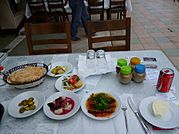 |
Minced meat cooked on skewers and served with parsley and sauce, on top of special Tire bread. |
| Tokat Kebab |  |
From the Tokat region, this kebab is made with marinated lamb, grilled in an oven with eggplants, tomatoes, potatoes, whole onions, and garlic. It's served over a special flatbread called lavaş. |
| Urfa kebabı | From Urfa, this kebab is similar to Adana kebab, but it's not spicy. | |
| Vali Kebabı |  |
Vali means Governor. |
Other Kebabs Around the World
Kebabs have traveled far and wide, inspiring many similar dishes in different cultures.
| Name | Image | Description |
|---|---|---|
| Chislic |  |
This dish came to South Dakota, USA, from Russian culture brought by German-Russian people. |
| Ražnjići |  |
A dish from the Western Balkan region, similar to shish kebab and shashlik. |
| Satay |  |
A Southeast Asian dish with diced or sliced meat, skewered and grilled over a fire. It's served with various spicy seasonings. It was created by Javanese street vendors, inspired by Indian kebabs. |
| Shashlik |  |
Shashlyk means skewered meat. It was originally made of lamb, but now it can also be made of pork or beef, depending on local tastes and traditions. |
| Shish kebab |  |
A very popular meal of skewered and grilled cubes of meat. |

